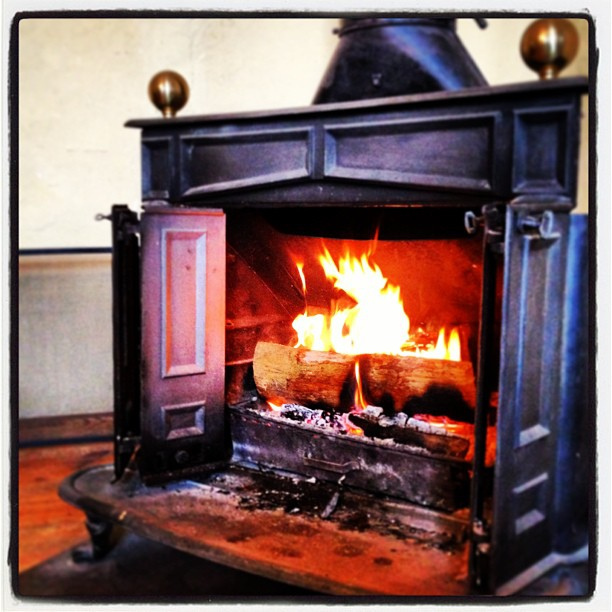The Benjamin Franklin stove is a remarkable invention that changed how people approached heating in the 18th century. This innovative fireplace, created by the polymath Benjamin Franklin, was designed to improve warmth and efficiency while reducing wood consumption. At a time when the weather was unpredictable and colder than ever, this historical invention reflected early American ingenuity and adaptability in the face of climate challenges. As Franklin sought to enhance indoor comfort, he also contributed to our understanding of atmospheric phenomena that affect weather technology today. His work epitomizes the spirit of climate adaptation during a period of significant environmental stress, showcasing how one invention can have profound implications for both comfort and scientific advancement.
The Franklin fireplace, also known as the Pennsylvania fireplace, stands out as one of the remarkable creations of its era. Benjamin Franklin’s revolutionary heating design exemplifies how early inventors approached the pressing challenges of their time with innovative solutions. This invention not only enhanced the warmth of homes but also played a crucial role in understanding the intricacies of atmospheric behavior and weather dynamics. In the context of historical inventions, Franklin’s work on the stove exemplifies the interplay between technology and society’s efforts to adapt to environmental changes. By rethinking conventional heating methods, Franklin paved the way for future advancements in climate technology.
The Ingenious Franklin Stove: A Climate Adaptation
Benjamin Franklin’s stove, also known as the Pennsylvania fireplace, emerged as a transformative invention during the harsh winter of 1740-1741, a notable period marked by extreme cold and perilous weather conditions. This unique prototype was designed to heat homes efficiently while using less firewood, a critical adaptation in the face of deforestation and exorbitant fuel costs faced by settlers. At its core, the Franklin stove embodied the principles of climate adaptation, offering a solution that not only catered to the pressing needs of the time but also demonstrated Franklin’s forward-thinking ideas regarding environmental management and comfort.
The evolving designs of the Franklin stove highlighted Franklin’s commitment to innovation, evolving from wood to coal as fuel to improve heating efficiency. This beloved invention reflects the broader themes of Franklin’s contributions to weather technology and atmospheric understanding. By experimenting with the stove’s design, Franklin not only aimed to enhance comfort in indoor environments but also to address the societal challenges posed by the relentless climate of his era.
Understanding Atmospheric Phenomena Through Franklin’s Innovations
Franklin’s insights extended far beyond the realm of stove technology; they significantly contributed to the understanding of atmospheric phenomena. His groundbreaking exploration of convection laid the groundwork for explaining how heated air travels, which played a crucial role in mapping storm systems and natural weather patterns. In his writings, Franklin articulately connected the operation of his heating innovations with the movement of atmospheric currents, specifically referencing the Gulf Stream. This ability to make complex scientific concepts accessible to the public demonstrates the profound impact of his work on advancing scientific literacy.
As scientists today grapple with understanding climate change and related atmospheric phenomena, Franklin’s early approaches serve as a reminder of the power of innovation driven by curiosity and necessity. His inventions not only addressed immediate problems of heating in extremely cold weather but also underscored the interplay between human activities and environmental conditions—a connection that remains critical as contemporary societies seek solutions to modern climate challenges.
The Legacies of Benjamin Franklin’s Weather Technology
The legacy of Franklin’s stove and his contributions to weather technology reverberate through time, reflecting an essential shift in how humanity interacts with the environment. Franklin’s work, often underappreciated, reveals crucial intersections between science, technology, and societal needs, showcasing how historical inventions can inform contemporary climate adaptation strategies. His ability to design a heating system that responded to immediate environmental challenges is a testament to the ingenuity of human innovation.
Today, we must recognize the importance of adapting historical lessons from figures like Franklin while shaping current and future technologies to mitigate climate issues. By acknowledging past innovations, including the Franklin stove, modern inventors and scientists can explore multidimensional solutions that address today’s climate crises while simultaneously respecting and understanding the atmospheric dynamics outlined by Franklin centuries ago.
Franklin’s Unintentional Revolution: Environmental Perspectives
Although Benjamin Franklin is often celebrated for his more famous inventions such as the lightning rod and bifocals, his work on the Franklin stove marks a significant sector of his environmental activism. In creating a more efficient heating system, he unintentionally revolutionized the way we perceive climate control and environmental responsibility. The stove problematized the act of burning wood versus coal and prompted considerations around energy efficiency and pollution, topics that resonate deeply in our ongoing conversations about climate change.
Franklin’s legacy thus serves as a critical narrative on how a single invention can influence societal attitudes toward environmental sustainability. In today’s context, as we adapt to urgent climate realities, revisiting Franklin’s original intent can illuminate pathways toward more responsible energy use and innovative practices that acknowledge our environmental footprint as a crucial element of lifestyle.
Exploring Franklin’s Impact on Modern Climate Solutions
As contemporary society faces unprecedented climate challenges, the ingenuity of historical figures like Benjamin Franklin offers valuable insight into developing modern solutions. Franklin’s staunch belief in the interplay between science and technology led him to continually seek out inventions that could mitigate pressing problems, including inefficient family heating methods. As we consider pathways to address climate change, Franklin’s innovations urge a critical reflection on how inventiveness can harness technology while consciously working towards improving comfort and sustainability.
Moreover, Franklin’s understanding of emissions and air quality through the lens of his stove invites today’s inventors to reimagine energy production and consumption. His push for minimizing smoke output reflects an early awareness of pollution trends, underscoring that the quest for optimization in technology is not only about efficiency but also about fostering a healthier environment. This call for comprehensive examination of energy solutions remains relevant and urgent as society seeks to balance comfort with sustainability.
Franklin’s Diverse Inventions: A Multifaceted Legacy
Benjamin Franklin’s diverse portfolio of inventions illustrates a multifaceted legacy that extends well beyond the confines of his famous contributions. The Franklin stove is one of many inventions that encapsulate his robust understanding of engineering and the practical application of scientific principles. This modernism stemmed from Franklin’s insatiable curiosity and adaptability, characteristics that are essential in contemporary inventors seeking to navigate our complex environmental landscape.
In recognizing Franklin’s contributions—including those to weather technology and atmospheric studies—we can encourage a broader dialogue about historical inventions and their relevance today. His work urges us to appreciate the interconnectedness of science and daily living, prompting a renaissance of thought surrounding how we innovate to improve our living conditions while respecting the earth’s natural processes.
The Intersection of Inventions and Social Responsibility in Franklin’s Work
An often overlooked aspect of Benjamin Franklin’s inventions, including the Franklin stove, is the inherent social responsibility embedded within them. Franklin was acutely aware of the challenges posed by an emerging industrial landscape, marked by issues such as deforestation and expensive firewood access for the poor. His drive for creating a more efficient stove was rooted not only in personal comfort but also in a consideration for those around him, exemplifying how technology can serve societal needs and elevate living standards.
This principle of social responsibility resonates today as we approach modern energy crises. By delving into historical examples of Franklin’s inventions, today’s innovators can draw inspiration from his commitment to designing technologies that address not just individual comforts but also collective welfare. As we face pressing climate challenges, it becomes imperative to prioritize inventions that culminate in environmental stewardship and the betterment of society as a whole.
Learning from Franklin: Innovating for Future Generations
As we reflect on the lessons from Benjamin Franklin’s life and his remarkable inventions, such as the Franklin stove, it becomes clear that innovation is a vital part of societal progress. His ability to create practical solutions for the pressing issues of his time is a guiding example for present-day inventors. In a world increasingly facing climate uncertainties, Franklin’s emphasis on science-led progress and innovation holds promise for future generations looking to develop sustainable solutions.
Ultimately, Franklin encourages us to embrace adaptability and creativity in our approach to solving today’s complex environmental problems. By learning from his multifaceted legacy, we can forge ahead with advancements in technology that honor both the past and future—matters of utmost importance as we endeavor to secure a healthier planet for those yet to come.
Engaging with Weather Technology: Franklin’s Lasting Relevance
The significance of Benjamin Franklin’s contributions to weather technology cannot be understated. By effectively linking his observations of atmospheric phenomena with practical inventions like the Franklin stove, he established a legacy of scientific inquiry that encourages ongoing exploration into the natural world. This engagement with weather technology not only showcased Franklin’s ingenuity but also laid the groundwork for future innovations in climate science.
Today, we still grapple with the complexities of weather systems and climate change, and Franklin’s work remains a valuable resource for understanding these phenomena. His systematic approach to examining and then manipulating environmental factors is a reminder of the power of inquiry and experimentation in confronting contemporary climate issues. As society continues to innovate under the pressures of climate change, the foundational principles established by Franklin will invariably guide and inform our efforts.
Frequently Asked Questions
What is the Benjamin Franklin stove and how does it work?
The Benjamin Franklin stove is an innovative fireplace design invented by Benjamin Franklin in the 18th century, aimed at improving heating efficiency. Unlike traditional open fireplaces, this stove uses a series of iron plates to create better airflow and enhance heat distribution through convection. The design allows for less wood consumption while providing greater warmth, making it a significant advancement in heating technology during a period marked by harsh winters.
How did the invention of the Franklin stove contribute to climate adaptation?
The Franklin stove was developed during the exceptionally cold winter of 1740-1741 as a response to climate challenges. As settlers expanded and deforestation increased firewood scarcity, Franklin’s design not only improved indoor heating but also showcased how weather technology can adapt to environmental issues. By allowing households to use less wood while staying warmer, Franklin’s invention served as a climate adaptation tool against harsh winter conditions.
What role did the Franklin stove play in the understanding of atmospheric phenomena?
The Franklin stove contributed to the understanding of atmospheric phenomena by illustrating principles of convection. Franklin explained how warm air rises and circulates within a room, which he also related to outdoor weather patterns, such as storm systems along the Atlantic coast and the Gulf Stream. This connection between heating technology and atmospheric science demonstrated how domestic inventions could enhance comprehension of larger environmental processes.
What environmental issues did Franklin address with his stove invention?
In his design of the Franklin stove, Benjamin Franklin addressed several environmental issues, including air quality and deforestation. Concerned about the pollution from smoky fires, he aimed to create a cleaner burning stove that would reduce smoke emissions, reflecting an early recognition of the health impacts of air pollution. His approach to minimizing emissions from the stove mirrored contemporary discussions on emissions and climate change.
How does the Franklin stove illustrate Benjamin Franklin’s innovative spirit?
The Franklin stove exemplifies Benjamin Franklin’s innovative spirit by combining practicality with scientific inquiry. By applying principles of physics to improve heating efficiency, Franklin not only created a useful household appliance but also advanced knowledge of convection and air circulation. His ability to adapt technology to meet environmental challenges showcases his legacy as a forward-thinking inventor and scientist.
What can modern society learn from Benjamin Franklin’s stove regarding climate solutions?
Modern society can learn from the Franklin stove about the importance of innovative thinking in developing climate solutions. Franklin’s emphasis on efficiency and minimizing emissions highlights the need for a multifaceted approach to environmental issues. His legacy encourages today’s inventors and policymakers to pursue diverse solutions rather than relying on a single ‘silver bullet’ approach to tackle climate change effectively.
In what ways did the Franklin stove influence heating technology over time?
The Franklin stove influenced heating technology by introducing the concept of controlled combustion and heat distribution. Over time, its design evolved to incorporate advancements in materials and fuel efficiency. This led to the development of modern stoves and heating systems that prioritize energy efficiency and comfort, marking a significant shift in how homes are heated while also addressing environmental concerns.
| Key Point | Details |
|---|---|
| Joyce Chaplin’s Exploration | Chaplin’s book focuses on Benjamin Franklin’s stove, an invention that transformed heating and provided insights into atmospheric phenomena. |
| Historical Context | The stove was invented during the harsh winter of 1740-41, which greatly impacted society, leading to famines and a demand for better heating. |
| Technology and Comfort | Franklin’s stove aimed to create a more efficient heating system that burned less wood, thus enhancing indoor comfort while responding to environmental challenges. |
| Scientific Impact | The principles of convection demonstrated by the stove contributed to Franklin’s understanding of weather patterns and helped explain natural phenomena like the Gulf Stream. |
| Sustainability Concerns | Franklin’s design aimed to minimize emissions, illustrating early concerns about air quality and the impact of smoke. |
| Lessons for Today | Chaplin suggests that modern environmental challenges require a multifaceted approach rather than a single solution, echoing Franklin’s innovative spirit. |
Summary
The Benjamin Franklin stove represents a significant innovation that not only made heating more efficient but also reflected the scientific curiosity and environmental awareness of its time. Joyce Chaplin’s exploration reveals how this creation sparked new thoughts on comfort, sustainability, and atmospheric science, which resonate with today’s climate challenges. Understanding Franklin’s impact encourages us to adopt a multifaceted approach to modern environmental issues, drawing inspiration from innovative thinkers of the past.



